Sometimes, spam bots fill in your newsletter signup forms and add dummy email addresses to your email list. When this happens, it can cost you money, and email service providers might mark your emails as spam.
So, we weren’t surprised when one of our readers asked us how to prevent newsletter signup spam in WordPress.
At WPBeginner and our other brands, we regularly send newsletters and use different techniques to grow our email list. We know how important it is to make sure our newsletter signups are authentic. To prevent signup spam, we use methods like reCAPTCHA, double optins, and email verification.
In this article, we will explain how to prevent newsletter signup spam in WordPress and keep your email list healthy and spam-free.
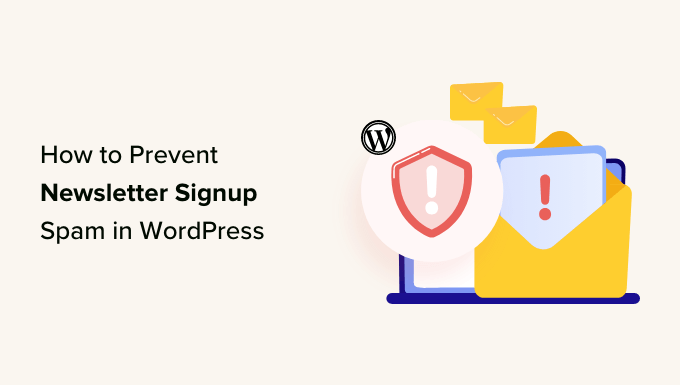
What Is Newsletter Signup Spam, and Why Prevent It?
Newsletter signup spam is when a bot fills in a form and joins your email list.
It happens because some spambots simply fill in all the forms they come across. They are hoping to get a message to you.
While newsletter signup spam may be less noticeable than comment spam and contact form spam, it can still cause problems.
Almost all email marketing services charge you based on the number of subscribers you have in your list. This means that you can end up paying for subscribers who are just bots, which is a waste of your money.
Plus, if you are sending out emails to bot email addresses that don’t exist, then this can potentially damage your sender’s reputation.
There are several ways to prevent newsletter signup spam, and in this article, we will cover all the best methods:
Method 1: Use Double Optin to Prevent Newsletter Signup Spam
Double optin, sometimes called confirmed optin, is useful in several ways. It means people have to confirm they want to receive your emails.
When users first sign up, they get a special email with a button or link to click. If they don’t click this, then they will not receive any further emails.
Here’s an example from the Elegant Themes email list:
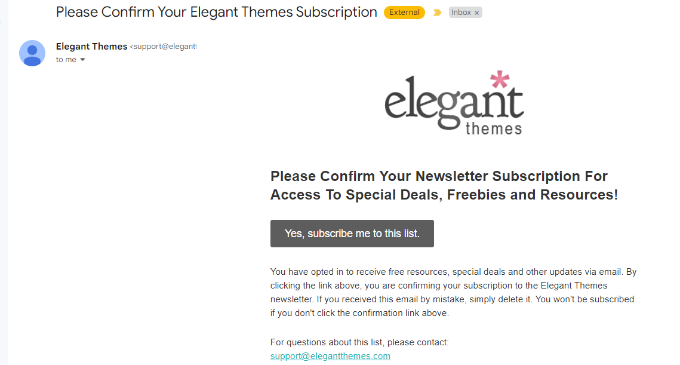
This method stops many spambots from becoming full members of your email list. They will not be counted in your total subscribers when your email marketing service bills you.
Double optin has many other benefits, too:
- You will only email people who truly want to be on your list.
- You will not be emailing addresses that don’t exist. This can happen if someone mistypes their email address when signing up.
- Your emails will be more likely to get through. Some mail providers require double optin in order to deliver emails.
All reputable email marketing services offer double optin. This setting often comes enabled by default.
Setting Up Double Optin With Constant Contact
Constant Contact is top of our list of the best email marketing services. It’s easy to set up double optin for your Constant Contact lists.
First, you need to log in to your Constant Contact email marketing account. Then, click on your name in the top right-hand corner and click the ‘My Account’ link.
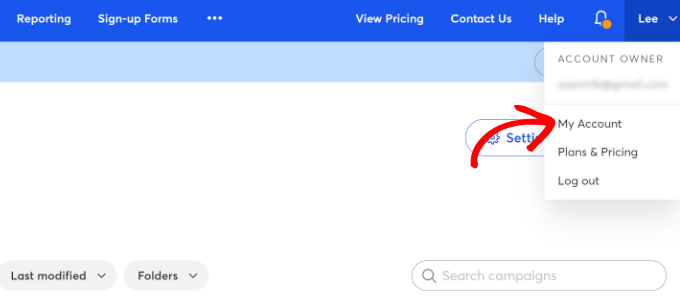
Once you are on the My Account page, simply switch to the ‘Advanced settings’ tab.
Next, click the ‘Manage’ link under the Manage contact emails section. This will take you to the Contact Emails page.
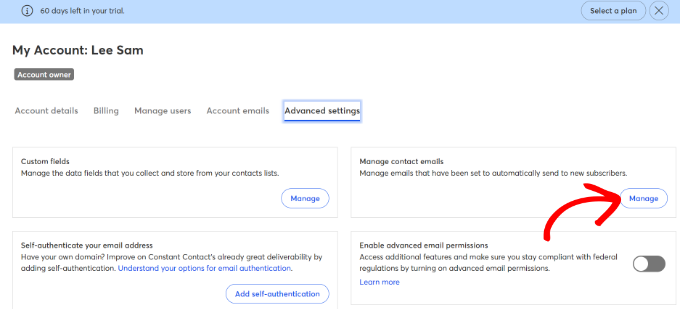
On the Contact Emails page, scroll down to the ‘Confirm Opt-in (Double Opt-in)’ section.
Here, you just need to click the ‘Activate’ button to turn on double optin.
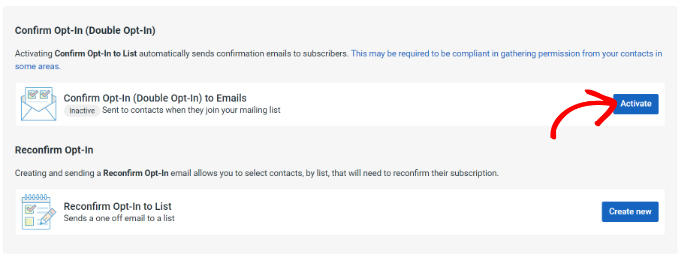
You will then see a popup asking you whether you want to continue.
Simply click the ‘Yes, Continue’ button.
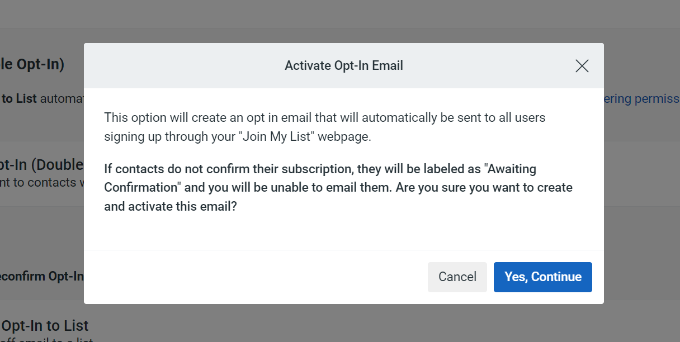
Constant Contact will now take you straight to the optin confirmation email.
You can edit the text of this email if you want. The email provider also provides several customization options. You can add images, buttons, videos, social follow links, and more.
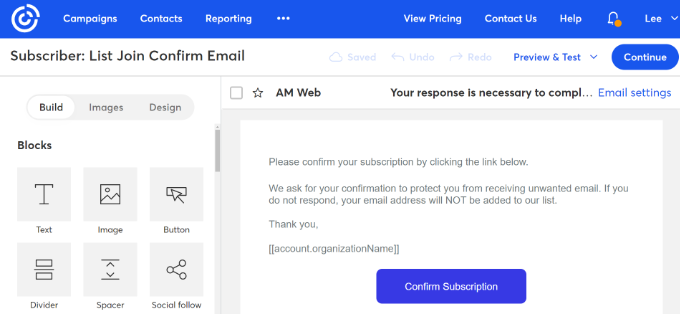
When you are done, simply click the ‘Continue’ button at the top.
On the next screen, you will see a preview of your email and other campaign details. Go ahead and click the ‘Activate’ button at the top.
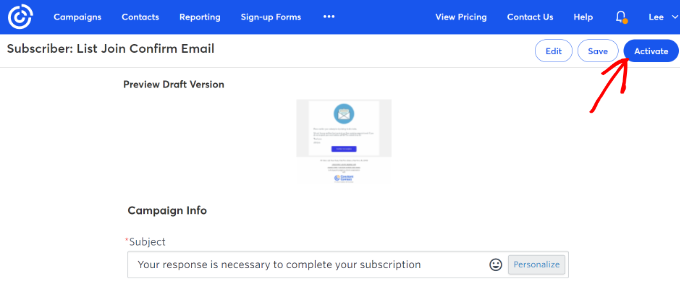
New subscribers to your email list will now receive a confirmation email. They need to click the ‘Confirm Subscription’ button to become full members of your list.
The process is similar to other email marketing services like Drip, Brevo (formerly Sendinblue), ConvertKit, Mailchimp, etc.
Unfortunately, some spambots are clever enough that they can click on email links and confirm their membership in your list. In that case, you can try some of these other methods to prevent them from signing up for your email list.
Method 2: Use reCAPTCHA on Your Newsletter Signup Form
Using reCAPTCHA is a great way to block spambots from completing your form and getting on your list in the first place.
We are going to show you how to use reCAPTCHA with 2 popular tools: OptinMonster and WPForms.
Using reCAPTCHA with OptinMonster to Prevent Email Signup Spam
OptinMonster is a popular lead-generation tool that you can use on your WordPress site. It lets you create a wide range of email signup forms, including popups, slide-in forms, inline forms, sticky bars, and more.
You can easily add a reCAPTCHA to your OptinMonster forms (optins).
To do so, you must first sign up for Google’s reCAPTCHA and register your site there. Just follow our step-by-step instructions on using reCAPTCHA for help with this.
It’s easy to integrate OptinMonster with Google reCAPTCHA. Simply log in to your OptinMonster account and click on your profile name. From here, you can click on the ‘Sites’ link in the dropdown menu.
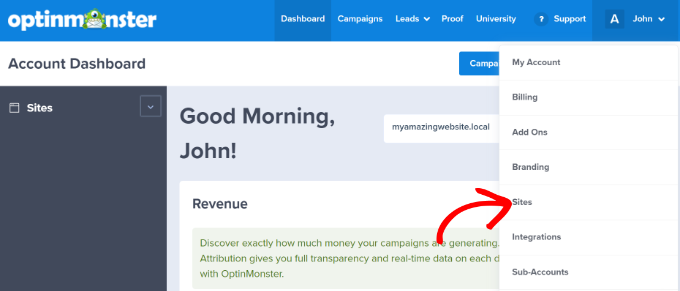
Here, you just need to find your website in the list.
Next, click on the ‘Edit’ link next to it.
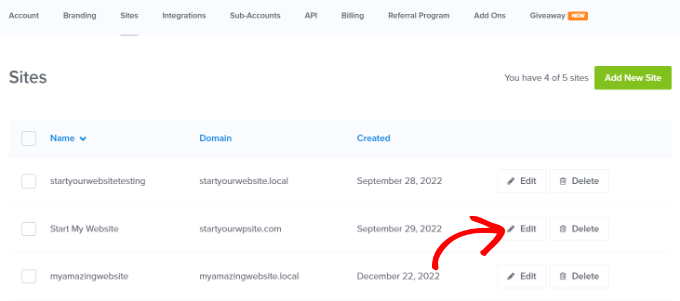
Now, go ahead and scroll down to the Google reCAPTCHA fields.
Copy your Site Key and Secret Key from your Google reCAPTCHA account here and enter them in the respective fields in OptinMonster.
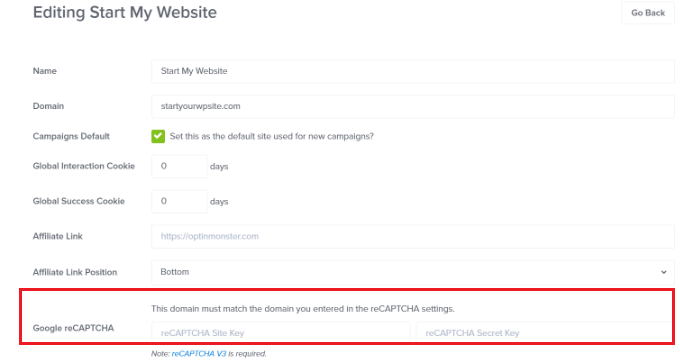
That’s all you need to do. All the email optin forms you create for that website will now be automatically protected against spam.
OptinMonster also offers a feature called TruLead, which is an AI-powered lead-filtering tool to block spam submissions. See our guide on the best email verification tools to learn more.
Using reCAPTCHA with WPForms to Prevent Email Signup Spam
If you are using WPForms for your newsletter signup form, then it’s easy to use reCAPTCHA to prevent bots from joining your list.
First, you need to enable reCAPTCHA by going to WPForms » Settings and clicking on the ‘reCAPTCHA’ tab.
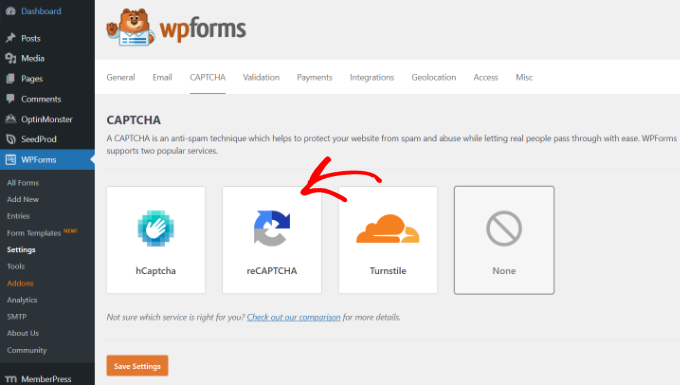
To do this, you will need a Site Key and Secret Key from Google. Just follow our step-by-step instructions on using reCAPTCHA for help with this.
Once you have enabled reCAPTCHA, go ahead and edit your newsletter signup form.
You just need to click on the reCAPTCHA field on the left-hand side.
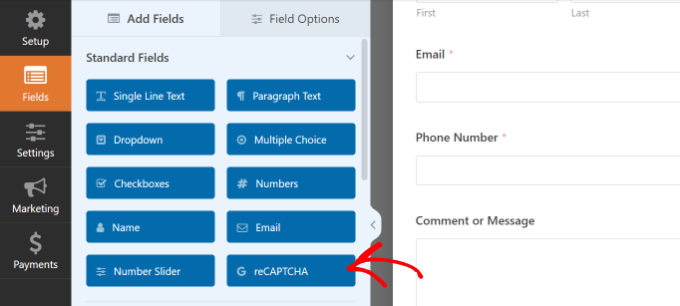
Then, you will see a message letting you know that reCAPTCHA has been enabled for your form.
Don’t forget to save your form changes when you’re ready.
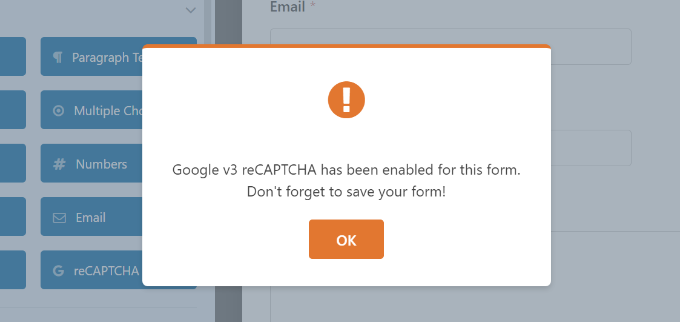
Your form will now have the reCAPTCHA logo on it, showing that reCAPTCHA is active.
Most users will not even notice the reCAPTCHA if you use the invisible version like us. They will only be prompted to complete a reCAPTCHA test if Google thinks they might be a bot.
Method 3: Use Smart Lead Verification From Emailable
Emailable offers an email verification service that checks email addresses on your list. You can use this service to remove duplicates, filter out temporary and disposable email addresses, and verify whether email addresses are active.
To get started, you can sign up by creating a new account or using your Google account.
After that, Emailable will ask you to select a source for your email list. You can drag and drop the contact list from your computer or select an email marketing platform.
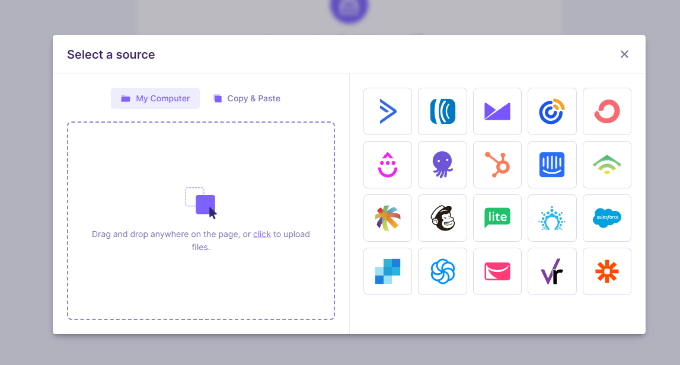
For this tutorial, we will select the Constant Contact option.
Next, you can select the email list you want to validate. For example, we will choose the ‘General Interest’ group from our Constant Contact account.
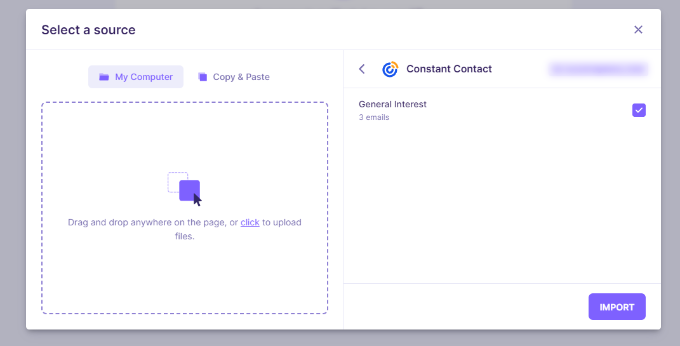
After that, go ahead and click the ‘Import’ button.
On the next screen, you can simply click the ‘Verify’ button to continue.
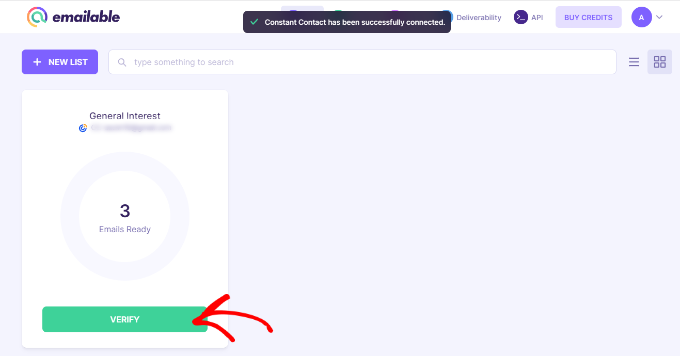
You will get a free quality report for all the lists you upload or import into the app. It shows which emails are deliverable and which are risky, duplicate, unknown, or undeliverable.
You can switch to the ‘Emails’ tab from the menu on the left to filter these emails.
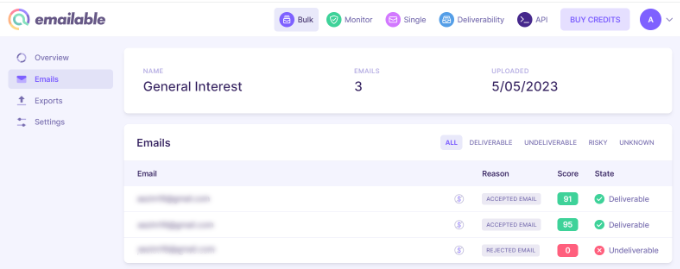
This lets you easily and quickly remove any spambots from your list.
OptinMonster also offers Lead Verification as a paid add-on. Here’s how to easily verify an email address with OptinMonster.
Method 4: Check Your List for Suspicious Email Addresses or Activity
If you don’t want to use a smart lead verification service, then you can manually remove suspicious email addresses from your email newsletter list.
There’s no perfect way to identify spambots, but one of the following indicators could be a bot:
- They have an unusual-looking email address, maybe with lots of numbers or multiple dots in it.
- They open 100% of your emails and click on every link. While this could be a very engaged subscriber, it’s likely to be a bot.
- They have never opened an email from you but have been a subscriber for a long time.
Once you have found suspicious email addresses on your list, you can simply delete these subscribers.
But what if you are not sure whether certain subscribers are real people or bots? You could tag them and then email them. Ask them to reply if they want to stay on your list. Then, go ahead and delete anyone who doesn’t reply.
To add a tag to a subscriber in Constant Contact, click the ‘Contacts’ tab, then click on your chosen list. Next, find your subscriber. The easiest way to do this is to search by their email address.
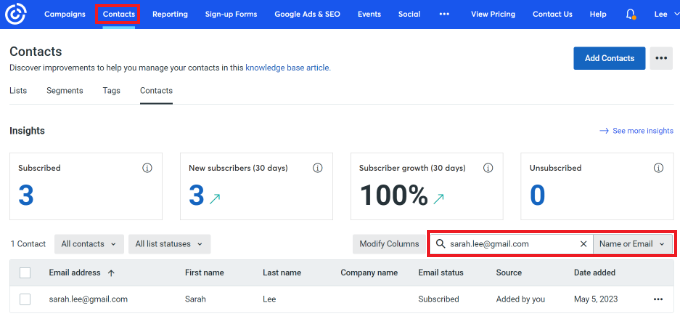
Next, click on the three dots to the right of the subscriber’s details.
From here, you can click the ‘Edit’ link.
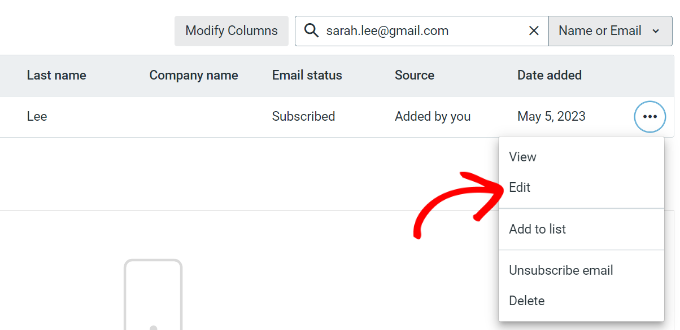
Tip: If you want to delete a subscriber, you can do that here by clicking the ‘Delete’ link.
Now, it’s time to add tags in the ‘Tags’ section on the right-hand side.
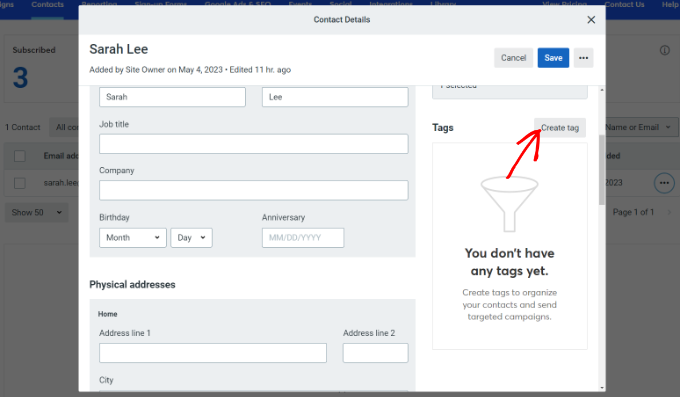
Go ahead and click the ‘Create tag’ button.
A new window will pop up. Simply enter the name of your tag and click the ‘Save’ button.
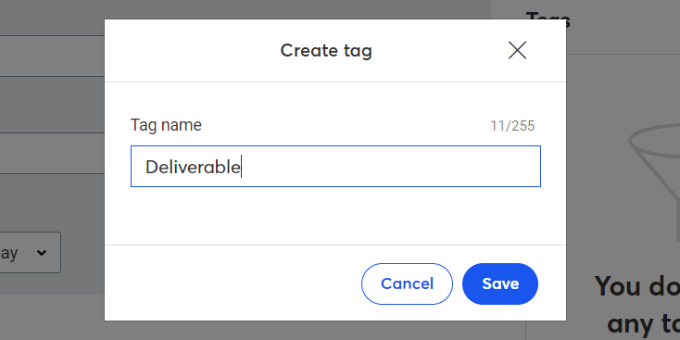
Once you have tagged all the subscribers who might be spambots, go ahead and create a new campaign.
Before sending out the campaign, you can select recipients with the tags you just set up to filter spam emails.
Email newsletter spambot subscribers can be expensive and irritating. Make sure you use at least one of the above methods to keep your email list healthy and bots-free.
We hope this article helped you learn how to prevent newsletter signup spam in WordPress. You might also want to see our tips on how to get more email newsletter subscribers and how to create a sales page in WordPress.
If you liked this article, then please subscribe to our YouTube Channel for WordPress video tutorials. You can also find us on Twitter and Facebook.





Dennis Muthomi
I added reCAPTCHA to my one of my clien’ts newsletter signup forms last month and saw a huge drop in spam subs.
One other thing I’d add is to regularly review your email list analytics. High open rates or click through rates from certain addresses can be a sign of bot activity so you can quickly identify and remove spam subs.
THANKGOD JONATHAN
I found this article on preventing newsletter spam in WordPress really helpful! The tip about using a CAPTCHA to stop bots from signing up was particularly useful. I’m going to implement that on my site right away.
Jiří Vaněk
The law of the Czech Republic together with the GDPR quite elegantly solved the problem of spam bots for us. Legislatively, we must require double verification for registration to the newsletter. A simple form is not enough. We are obliged to send an email to the user who wants to subscribe to the newsletter, and the user must confirm the addition of his email address. This prevents someone from using a foreign address without the owner’s knowledge. We can send the newsletter to the user only when he verifies his e-mail address that he is really the one who wants to subscribe to the list. Not only is it a more secure form of creating a mailing list, but it also greatly limits the possibilities of spam bots who would need to have a physical email address and confirm verification emails. In this context, the GDPR law is quite good.
Otherwise, a great form of registration form protection that I use is WP Armour, which works with the WPForms plugin. From my personal experience, I have not noticed a single false registration in the last year. It works perfectly and runs in the background without bothering the user with logic tasks or similar mechanism to verify if you are human.
Ahmed Omar
I am using recaptcha as it is easy and does not need too much
Thank you for this post
Ralph
I think double optin is the best. My country law recuire it anyway but it prevent spam 100%, at least in my case. What is even more important it filters out people who are going to read from inactive contacts. What is important, after sign up i redirect to “thank you” page with information, that you have to confirm by double optin. Without that info some people don’t know they have to do this.